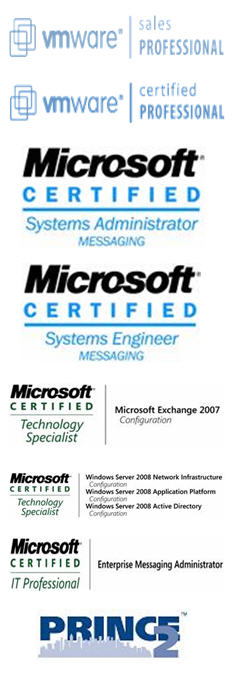Last week, we had a discussion over the design and configuration of an Exchange 2007 server in a DRS.
Of course, as always, there isn’t one answer that fits all. There are a few questions you need to answer to get to a solution that fits your needs:
- How will the data be replicated to the server located in the DRS?
- How performant is the link between the main site and the DRS?
- How important is are the e-mails within your company?
- How much money do you have to spend?
Let’s go over the questions one by one to come to our solution.
1. How will the data be replicated to the server located in the DRS?
There are 4 different replication menthods:
a) Synchronous replication: the Exchange host receives a “successful write” response when the operation is complete on the local AND remote locations.
Advantages:
I. guaranteed no data loss (how is that for a sole advantage … )
Disadvantage:
I. reduced performance (site link, link utilization, distance very important since mails have to saved to both local and remote storage)
II. more expensive than asynchronous replication
III. need for 3rd party software
b) Asynchronous replication: the Exchange host writes to the local storage and the data is replicated independently afterwards
Advantages:
I. not as heavy on performance indicators as synchronous replication
II. cheaper than synchronous replication
III. native Exchange 2007 technology (LCR, SCR & CCR)
IV. robust: (in case of a CCR no single failure will lead to a loss of service)
Disadvantages:
I. no guarantee against data loss can be provided
c) Host-based replication: a filter driver manages the replication (and needs to cut the I/O stream to do this)
d) Storage-based replication: replication at storage level (more performant than host-based replication)
2. How performant is the link between the main site and the DRS?
Whether you choose synchronous or asynchronous replication might not just depend on the budget you have to spend, but also on the environment that is already in place. Be aware that choosing synchronous replication will not only reduce the number of mailboxes per server (up to 75 % reduction in mailboxes/server scalability), the site link is largely impacted as well.
The tools LoadSim and JetStress are developed by Microsoft to test latencies and storage throughput.
3. How important is are the e-mails within your company?
As said above, asynchronous replication cannot guarantee that all data will be retained in case of a “disaster”, while synchronous replication does (providing the site links are operational). However, Exchange 2007 is designed to lose as little information as possible in case of a failure. Thanks to the LCR, CCR and SCR technologies, the losses should be minimized to read/unread messages statuses, incomplete contact, calendar entries, … If this is acceptable for your SLA, they offer a really good solution. Of course, if databases have to be moved to a new stand-by Exchange server, some downtime will be unavoidable.
4. How much money do you have to spend?
I guess this point is pretty clear. Choosing between LCR, SCR and CCR have already huge price effects on your budget. If your SLA requires you to choose for synchronous replication, this price will mount exponentially since third party software will have to be purchased, installed, configured, received training on, …
Tuesday, January 27, 2009
Subscribe to:
Post Comments (Atom)


No comments:
Post a Comment